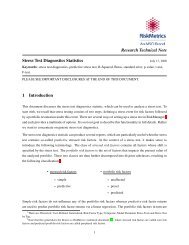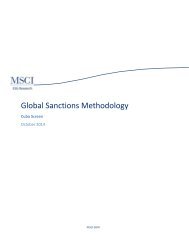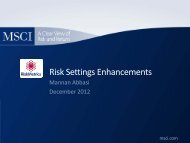Pdf of Presentation - RiskMetrics Online Help Files - MSCI
Pdf of Presentation - RiskMetrics Online Help Files - MSCI
Pdf of Presentation - RiskMetrics Online Help Files - MSCI
- No tags were found...
Create successful ePaper yourself
Turn your PDF publications into a flip-book with our unique Google optimized e-Paper software.
Risk Settings in RiskManager:Factors to Consider forAppropriate SetupOctober 20, 2011©2011. All rights reserved. msci.com
Agenda• Introduction to Risk Settings in RiskServer• How to parameterize Risk Settings• Upcoming features for Value at Risk (VaR) calculations©2011. All rights reserved.msci.com2
Introduction to RiskSettings©2011. All rights reserved. msci.com3
Introduction to Risk Settings• Analysis & Pricing Dates• Analysis & Return Horizon• Decay Factor• Time Series Return Definitions• Pricing Model Settings• (Use upfront to Discount Bond Settings)©2011. All rights reserved.msci.com4
Risk Settings (aka Valuation Spec)• In order to run a report you need:• Positions, Statistics, Row drill-downs, Risk Settings• Risk Settings are required in any RiskServer report template• Collection <strong>of</strong> parameters that have a direct impact on the valuation, risk orsensitivity measures and stress test results <strong>of</strong> individual securities and atthe aggregate level• Fully customizable by the user©2011. All rights reserved.msci.com5
Risk Settings - Part 1©2011. All rights reserved.msci.com6
Risk Settings - Time Series Dates• Determines how much historical data to use in the risk measures• E.g. last 2 years, last 24 months, last 520 business or calendar days• A single or multiple time period: e.g. 04/01/2010 – 10/06/2011 and 01/01/2008 –31/12/2008• The order matters!©2011. All rights reserved.msci.com7
Risk Settings - Time Series Dates• Time Series Dates: 2008 + 2010 (levels and returns)time©2011. All rights reserved.msci.com8
Risk Settings - Time Series Dates• Time Series Dates: 2010 + 2008time• Historical VaR will show no difference whichever order is selected• Once a Decay Factor is used (Parametric or Monte Carlo) more weight will be given tothe latest returns so having 2008 as the latter period will result in much higher volatility• The order matters!• Usage: Revised 2008 Stress Test, Hectic Days©2011. All rights reserved.msci.com9
Risk Settings – Sampling Frequency• Sampling Frequency (Return Horizon in RiskManager version 3)• Length <strong>of</strong> returns that are taken from the historical time series data• E.g. 21 days (business days), 1 Month or end <strong>of</strong> month returns• We call these Sample Returns• Given 2 years <strong>of</strong> historical data we can extract around 24 21-day returns with nooverlapping• 2 years <strong>of</strong> data, 21-day returns and 20 days overlapping provides close to 500 21-dayreturns (not recommended due to serial correlation)©2011. All rights reserved.msci.com10
Risk Settings – Analysis Horizon• Analysis Horizon• Holding Period, VaR Horizon• 5 Day Analysis Horizon results in one week VaR numbers• Scales the returns specified in the Sampling Frequency• Does not scale the statistic directly• Always entered in Business Days• Analysis Horizon Scaling• Each Sample Return is scaled by the Analysis Horizon with Square Root <strong>of</strong> time rule• Sample Frequency = 5D, Analysis Horizon = 21D• Return21D = Sqrt(21/5)*Return5D• The Scaled Returns are used in the risk calculations as usual• Typically 5D VaR 5*1D VaR unless Parametric Methodology is applied©2011. All rights reserved.msci.com11
Risk Settings – Time Series Definitions• Allows users to specify what returns each data type shall use• Log Returns or Difference Returns• Log(P t /P t-1 ) or P t – P t-1• Useful for Time Series with small values• By default Difference Returns are only applied to Interest Rates inRiskServer©2011. All rights reserved.msci.com12
Risk Settings – Time Series Definitions• Difference Returns for CDS Spreads show more reasonable levels©2011. All rights reserved.msci.com13
Risk Settings – Decay Factor• Decay Factor – Exponentially Weighted Moving Average (EWMA)• Recent returns are given more weight the small the decay factor is• No Decay means Lambda = 1, Equal weight©2011. All rights reserved.msci.com14
Risk Settings - Part 2©2011. All rights reserved.msci.com15
Risk Settings – Currency Basket• Used to create a synthetic basket <strong>of</strong> currencies that can be used asbase/reporting currency• Example: Special Drawing Right (SDR) for the Bank <strong>of</strong> InternationalSettlements since April 2003• 1. Jan 2006: 1 SDR = USD0.632 + EUR0.41 + JPY18.4 + GBP0.0903 (to be reviewed every 5years)• http://www.bis.org/banking/bank_reporting_currency.htm©2011. All rights reserved.msci.com16
Risk Settings – Time Series Type Settings• Mean Reversion• Only Applicable in Counterparty Credit Exposure Reports• Some time series empirically show mean reverting behaviour such as Interest Rates, CDSSpreads and Implied Volatilities• User can define after what period a time series shall revert back to its mean©2011. All rights reserved.msci.com17
Risk Settings – Liquidity Fraction• The fraction <strong>of</strong> daily volume that if sold <strong>of</strong>f will not affect market price• Example: Average Daily Volume 5mln shares, Liquidity Fraction 10%Selling 500,000 shares within a day will not affect the market price• Liquidity fraction is used in the statistics• Liquidity Horizon• Liquidity Adjusted VaR• Average Daily Volume is populated in the Terms and Conditions for most equities• Default Value is 0.1 (10%)©2011. All rights reserved.msci.com18
Risk Settings – Liquidity Fraction, Issuer Mapping Rules• Mapping table <strong>of</strong> CDS Spread curve to Issuer Name• Used for Jump To Default stress test only• What happens to the position or portfolio if an issuer defaults©2011. All rights reserved.msci.com19
Risk Settings – Pricing Model Settings• Pricing Model settings – to modify underlying analytics <strong>of</strong> models• Convertible Bond Settings – Step Length Scalar• The CB model uses an equity tree that has a node on each cash flow or option (call/put) day• Entering Scalar as 2 will half the step size and therefore double the number <strong>of</strong> nodes in the tree• Use reasonably with Monte Carlo statistics, useful for Present Value and Delta• Generic Bond – Implied Spread Floor• Puts a floor on the Credit Spread (Issuer OAS + Idiosyncratic OAS)• Credit Spread = Max (Floor, Issuer OAS + Idiosyncratic OAS)©2011. All rights reserved.msci.com20
Risk Settings – Other• Other options• Use Cash when out-<strong>of</strong>-range client Price• If calibration fails the user-entered price will be ignored and the difference between model and user price willbe added as CASH.• Use Upfront to discount bond transformations• Upfront returns calculated based on 1-U from U• By default the ‘shift method’ is used to adjust upfront price: add spread*term 1)1)See Section 3 <strong>of</strong> Measuring CDS Value at Risk,©2011. All rights reserved.msci.com21
Parameterize RiskSettings©2011. All rights reserved. msci.com22
How to Parameterize Risk Settings• Sample Frequency• Decay Factor• Time Series Dates©2011. All rights reserved.msci.com23
Sampling Frequency, Analysis Horizon and Time Series Dates• Ideally for 1 Month Holding Period use monthly returns over a longerperiod <strong>of</strong> time• Problems to consider:• lack <strong>of</strong> monthly returns in case <strong>of</strong> some equities (newly listed)• Higher sample error• What Decay Factor will capture the best volatility estimate• Overlapping <strong>of</strong> data not recommended, because autocorrelation violates the assumption<strong>of</strong> independent returns (OLS regression in stress tests requires error terms to beuncorrelated)©2011. All rights reserved.msci.com24
Sampling Frequency, Analysis Horizon and Time Series Dates• Example: There are 24 independent monthly returns over 2 years• Historic Simulation• Only these 24 returns will be used in calculating the historical risk measures (VaR, CVaR,Marginal Var, Standard Deviation, …)• Small sample size, higher standard error• Decay Factor is not taken into account• Parametric method• Only the above 24 monthly returns will be used to generate the Covariance Matrixtaking the decay factor into account• Higher margin <strong>of</strong> error• Decay factor is used, which one should be used, concept <strong>of</strong> Half Life©2011. All rights reserved.msci.com25
Sampling Frequency, Analysis Horizon and Time Series Dates• Monte Carlo Simulation• Bootstrapping method applied to the same 24 monthly returns from the previousexample to generate N independent identically distributed returns 3)• Decay Factor is used• Common method for capturing 1-month VaR©2011. All rights reserved.msci.com26
Sampling Frequency, Analysis Horizon and Time Series Dates• For Historic and Parametric methodology <strong>of</strong>ten daily returns (SamplingFrequency) are used with the required Holding Period (Analysis Horizon)• Problem with this is that correlations between different geographical markets may notbe captured properly, weekly sampling frequency over 2 years or more is used in thiscase• A good example to illustrate this is looking at the Nikkei 225 and S&P 500 equity indices.They are in different geographical regions and not uncorrelated.©2011. All rights reserved.msci.com27
Parameterize Risk Settings• Nikkei 225 vs S&P 500, daily and weekly returns• Total data used 01/01/2010 – 31/12/2010• Graph <strong>of</strong> log returns for May 2010• Using weekly returns is more in line with expectationsCorrelations over 1 yearDaily Weekly0.22 0.74©2011. All rights reserved.msci.com28
Decay Factor• Compare Decay Factors• Used to indicate how much many returns are used in the volatility calculations• Decay H = 0.5, half-life H• Half-life <strong>of</strong> 3 months means that the weight in the return 3M ago is half that <strong>of</strong> the return with the biggestweight (last return)• Another way to look at decay factor is to associate it with number <strong>of</strong> returns that makeup a given percentage <strong>of</strong> estimated volatility©2011. All rights reserved.msci.com29
Decay Factor• Daily Sampling Frequency used• With Decay Factor 0.94, the last 74 daily returns make up 99% <strong>of</strong> volatilityfor that risk factor©2011. All rights reserved.msci.com30
Decay Factor• Returns as function <strong>of</strong> Decay Factorλ=0.94 0.991.0• λ=1, No Decay, Equal weighting• λ=0.94, 99% <strong>of</strong> volatility is made <strong>of</strong> the last 74 returns©2011. All rights reserved.msci.com31
Risk Setting choices• Aim: Good estimation <strong>of</strong> Volatility and Correlations• Assumption that sample mean is zero• Reduce standard error <strong>of</strong> the estimate• Reduce standard error for all risk factors, not just one• Only one decay factor is applied to all risk factors• Empirical methods can be used to determine a suitable Decay Factor©2011. All rights reserved.msci.com32
Risk Setting choices• Root Mean Square Error• Reducing Root Mean Square Error implies a good estimate• This is a good statistical process for a single estimate, but we need to find a stableParameter that works without having to update the single decay factor on a daily basis©2011. All rights reserved.msci.com33
Risk Setting choices - Stability• Stability is important• Risk managers should not have to update their Risk Settings on a daily basis• Need to find stable parameters that provide good forecasts• The higher the decay factor, the smoother history <strong>of</strong> volatilities©2011. All rights reserved.msci.com34
Risk Setting choices - Stability• Optimal Decay Factors based on volatility forecasts (RMSE criterion)©2011. All rights reserved.msci.com35
Risk Setting choices - Stability• Define• N number <strong>of</strong> time series (480), t i is the i th root mean square deviation(RMSE) associated with• Relative Error• Weight• Optimal Decay Factor• Optimal Decay Factor is average <strong>of</strong> individual optimal decay factorsweighted by individual forecast accuracy©2011. All rights reserved.msci.com36
Risk Setting choices - Stability• In case <strong>of</strong> 0.94 decay only the last 75 observations will have an effect onthe risk measures• With 0.94 using 1 year or 10 years <strong>of</strong> daily returns should make nosignificant difference to Parametric or Monte Carlo VaR, but processing willbe slower in the latter case (not linear though)©2011. All rights reserved.msci.com37
Risk Setting choices - Stability• Further points• Using Decay Factor is appropriate for current volatility estimation <strong>of</strong> non-stationaryreturns• Apply daily sampling frequency with the required analysis horizon for standalonevolatility measures• 5-Day returns is a common way <strong>of</strong> capturing correlations across geographical markets• Square root <strong>of</strong> time rule is applied to the returns, not directly to VaR• Select appropriate length <strong>of</strong> history, not too little, but also not too much©2011. All rights reserved.msci.com38
Useful Features forVolatilityCalculations©2011. All rights reserved. msci.com39
Research and Development• Decoupling <strong>of</strong> Volatilities and Correlations• Event-Driven VaR©2011. All rights reserved.msci.com40
Research and Development• Decoupling <strong>of</strong> Correlations and Volatilities• Currently a single decay factor and sampling frequency applied are to all risk factors forvolatility and correlation calculations• R&D are looking at allowing one sampling frequency for correlation calculations andanother sampling frequency for volatility estimation• A planned stress test overhaul will also focus on using more suitable correlations in thepredictive stress test regressions©2011. All rights reserved.msci.com41
Research and Development• Event-driven VaR• EWMA is a way to estimate volatility to be used in VaR• Research and Development is looking at using Implied volatility surfaces to forecastfuture volatility, this is a more market-driven forecast and should be more useful forLong Term VaR©2011. All rights reserved.msci.com42
References1. Measuring Value at Risk, Catherine O’Neil, April 20102. <strong>RiskMetrics</strong> Technical Document, 19963. A general approach to calculating VaR without volatilities andcorrelations, Benson & Zangari, 19974. Updated Stress Testing Features in <strong>RiskMetrics</strong> RiskManager, Sept 2011©2011. All rights reserved.msci.com43
<strong>MSCI</strong> 24 Hour Global Client ServiceAmericasEurope, Middle East & AfricaAsia PacificAmericas1.888.588.4567 (toll free)Cape Town +27.21.673.0100China North10800.852.1032 (toll free)Atlanta +1.404.551.3212Frankfurt +49.69.133.859.00China South10800.152.1032 (toll free)Boston +1.617.532.0920Geneva +41.22.817.9777Hong Kong +852.2844.9333Chicago +1.312.706.4999London +44.20.7618.2222Seoul+798.8521.3392 (toll free)Monterrey +52.81.1253.4020Milan +39.02.5849.0415Singapore800.852.3749 (toll free)Montreal +1.514.847.7506Paris0800.91.59.17 (toll free)Sydney +61.2.9033.9333New York +1.212.804.3901Tokyo +81.3.5226.8222San Francisco +1.415.836.8800São Paulo +55.11.3706.1360Stamford +1.203.325.5630Toronto +1.416.628.1007clientservice@msci.comwww.msci.com | www.riskmetrics.comBarra Knowledge Base – <strong>Online</strong> Answers to Barra Questions: www.barra.com/supportmsci.com 44©2011. All rights reserved. msci.com 44
Notice and Disclaimer• This document and all <strong>of</strong> the information contained in it, including without limitation all text, data, graphs, charts (collectively, the “Information”) is the property <strong>of</strong> MSCl Inc. or itssubsidiaries (collectively, “<strong>MSCI</strong>”), or <strong>MSCI</strong>’s licensors, direct or indirect suppliers or any third party involved in making or compiling any Information (collectively, with <strong>MSCI</strong>, the“Information Providers”) and is provided for informational purposes only. The Information may not be reproduced or redisseminated in whole or in part without prior writtenpermission from <strong>MSCI</strong>.• The Information may not be used to create derivative works or to verify or correct other data or information. For example (but without limitation), the Information may not be usedto create indices, databases, risk models, analytics, s<strong>of</strong>tware, or in connection with the issuing, <strong>of</strong>fering, sponsoring, managing or marketing <strong>of</strong> any securities, portfolios, financialproducts or other investment vehicles utilizing or based on, linked to, tracking or otherwise derived from the Information or any other <strong>MSCI</strong> data, information, products or services.• The user <strong>of</strong> the Information assumes the entire risk <strong>of</strong> any use it may make or permit to be made <strong>of</strong> the Information. NONE OF THE INFORMATION PROVIDERS MAKES ANY EXPRESS ORIMPLIED WARRANTIES OR REPRESENTATIONS WITH RESPECT TO THE INFORMATION (OR THE RESULTS TO BE OBTAINED BY THE USE THEREOF), AND TO THE MAXIMUM EXTENTPERMITTED BY APPLICABLE LAW, EACH INFORMATION PROVIDER EXPRESSLY DISCLAIMS ALL IMPLIED WARRANTIES (INCLUDING, WITHOUT LIMITATION, ANY IMPLIED WARRANTIES OFORIGINALITY, ACCURACY, TIMELINESS, NON-INFRINGEMENT, COMPLETENESS, MERCHANTABILITY AND FITNESS FOR A PARTICULAR PURPOSE) WITH RESPECT TO ANY OF THEINFORMATION.• Without limiting any <strong>of</strong> the foregoing and to the maximum extent permitted by applicable law, in no event shall any Information Provider have any liability regarding any <strong>of</strong> theInformation for any direct, indirect, special, punitive, consequential (including lost pr<strong>of</strong>its) or any other damages even if notified <strong>of</strong> the possibility <strong>of</strong> such damages. The foregoing shallnot exclude or limit any liability that may not by applicable law be excluded or limited, including without limitation (as applicable), any liability for death or personal injury to theextent that such injury results from the negligence or wilful default <strong>of</strong> itself, its servants, agents or sub-contractors.• Information containing any historical information, data or analysis should not be taken as an indication or guarantee <strong>of</strong> any future performance, analysis, forecast or prediction. Pastperformance does not guarantee future results.• None <strong>of</strong> the Information constitutes an <strong>of</strong>fer to sell (or a solicitation <strong>of</strong> an <strong>of</strong>fer to buy), any security, financial product or other investment vehicle or any trading strategy.• <strong>MSCI</strong>’s indirect wholly-owned subsidiary Institutional Shareholder Services, Inc. (“ISS”) is a Registered Investment Adviser under the Investment Advisers Act <strong>of</strong> 1940. Except withrespect to any applicable products or services from ISS (including applicable products or services from <strong>MSCI</strong> ESG Research Information, which are provided by ISS), none <strong>of</strong> <strong>MSCI</strong>’sproducts or services recommends, endorses, approves or otherwise expresses any opinion regarding any issuer, securities, financial products or instruments or trading strategies andnone <strong>of</strong> <strong>MSCI</strong>’s products or services is intended to constitute investment advice or a recommendation to make (or refrain from making) any kind <strong>of</strong> investment decision and may notbe relied on as such.• The <strong>MSCI</strong> ESG Indices use ratings and other data, analysis and information from <strong>MSCI</strong> ESG Research. <strong>MSCI</strong> ESG Research is produced by ISS or its subsidiaries. Issuers mentioned orincluded in any <strong>MSCI</strong> ESG Research materials may be a client <strong>of</strong> <strong>MSCI</strong>, ISS, or another <strong>MSCI</strong> subsidiary, or the parent <strong>of</strong>, or affiliated with, a client <strong>of</strong> <strong>MSCI</strong>, ISS, or another <strong>MSCI</strong>subsidiary, including ISS Corporate Services, Inc., which provides tools and services to issuers. <strong>MSCI</strong> ESG Research materials, including materials utilized in any <strong>MSCI</strong> ESG Indices orother products, have not been submitted to, nor received approval from, the United States Securities and Exchange Commission or any other regulatory body.• Any use <strong>of</strong> or access to products, services or information <strong>of</strong> <strong>MSCI</strong> requires a license from <strong>MSCI</strong>. <strong>MSCI</strong>, Barra, <strong>RiskMetrics</strong>, ISS, CFRA, FEA, and other <strong>MSCI</strong> brands and product names arethe trademarks, service marks, or registered trademarks or service marks <strong>of</strong> <strong>MSCI</strong> or its subsidiaries in the United States and other jurisdictions. The Global Industry ClassificationStandard (GICS) was developed by and is the exclusive property <strong>of</strong> <strong>MSCI</strong> and Standard & Poor’s. “Global Industry Classification Standard (GICS)” is a service mark <strong>of</strong> <strong>MSCI</strong> and Standard& Poor’s.© 2011 <strong>MSCI</strong> Inc. All rights reserved. RV May 2011msci.com 45©2011. All rights reserved. msci.com 45
















